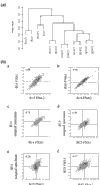Gene expression profiles derived from fine needle aspiration correlate with response to systemic chemotherapy in breast cancer
- PMID: 12052255
- PMCID: PMC111028
- DOI: 10.1186/bcr433
Gene expression profiles derived from fine needle aspiration correlate with response to systemic chemotherapy in breast cancer
Abstract
Background: Drug resistance in breast cancer is a major obstacle to successful chemotherapy. In this study we used cDNA microarray technology to examine gene expression profiles obtained from fine needle aspiration (FNA) of primary breast tumors before and after systemic chemotherapy. Our goal was to determine the feasibility of obtaining representative expression array profiles from limited amounts of tissue and to identify those expression profiles that correlate with treatment response.
Methods: Repeat presurgical FNA samples were taken from six patients who were to undergo primary surgical treatment. Additionally, a group of 10 patients who were to receive neoadjuvant chemotherapy underwent two FNAs before chemotherapy (adriamycin 60 mg/m2 and cyclophosphamide 600 mg/m2) followed by another FNA on day 21 after the first cycle. Total RNA was amplified with T7 Eberwine's procedure and labeled cDNA was hybridized onto a 7600-feature glass cDNA microarray.
Results: We identified candidate gene expression profiles that might distinguish tumors with complete response to chemotherapy from tumors that do not respond, and found that the number of genes that change after one cycle of chemotherapy was 10 times greater in the responding group than in the non-responding group.
Conclusion: This study supports the suitability of FNA-derived cDNA microarray expression profiling of breast cancers as a comprehensive genomic approach for studying the mechanisms of drug resistance. Our findings also demonstrate the potential of monitoring post-chemotherapy changes in expression profiles as a measure of pharmacodynamic effect and suggests that these approaches might yield useful results when validated by larger studies.
Figures



Similar articles
-
Gene expression profiles of breast cancer obtained from core cut biopsies before neoadjuvant docetaxel, adriamycin, and cyclophoshamide chemotherapy correlate with routine prognostic markers and could be used to identify predictive signatures.Zentralbl Gynakol. 2006 Apr;128(2):76-81. doi: 10.1055/s-2006-921508. Zentralbl Gynakol. 2006. PMID: 16673249 Clinical Trial.
-
Gene trio signatures as molecular markers to predict response to doxorubicin cyclophosphamide neoadjuvant chemotherapy in breast cancer patients.Braz J Med Biol Res. 2010 Dec;43(12):1225-31. doi: 10.1590/s0100-879x2010007500135. Epub 2010 Nov 26. Braz J Med Biol Res. 2010. PMID: 21103787
-
Gene expression profile associated with response to doxorubicin-based therapy in breast cancer.Clin Cancer Res. 2005 Oct 15;11(20):7434-43. doi: 10.1158/1078-0432.CCR-04-0548. Clin Cancer Res. 2005. PMID: 16243817 Clinical Trial.
-
Transcriptional profile and response to neoadjuvante chemotherapy in breast cancer.Rev Assoc Med Bras (1992). 2011 May-Jun;57(3):347-52. Rev Assoc Med Bras (1992). 2011. PMID: 21691702 Review. English, Portuguese.
-
Current progress in the prediction of chemosensitivity for breast cancer.Breast Cancer. 2004;11(1):42-8. doi: 10.1007/BF02968001. Breast Cancer. 2004. PMID: 14718792 Review.
Cited by
-
Breast cancer classification and prognosis based on gene expression profiles from a population-based study.Proc Natl Acad Sci U S A. 2003 Sep 2;100(18):10393-8. doi: 10.1073/pnas.1732912100. Epub 2003 Aug 13. Proc Natl Acad Sci U S A. 2003. PMID: 12917485 Free PMC article.
-
High rates of breast conservation for large ductal and lobular invasive carcinomas combining multimodality strategies.Br J Cancer. 2008 Feb 26;98(4):734-41. doi: 10.1038/sj.bjc.6604229. Epub 2008 Feb 5. Br J Cancer. 2008. PMID: 18253121 Free PMC article.
-
Fine-needle aspiration biopsies for gene expression ratio-based diagnostic and prognostic tests in malignant pleural mesothelioma.Clin Cancer Res. 2011 Jan 15;17(2):310-6. doi: 10.1158/1078-0432.CCR-10-0806. Epub 2010 Nov 18. Clin Cancer Res. 2011. PMID: 21088255 Free PMC article.
-
Alteration of cellular behavior and response to PI3K pathway inhibition by culture in 3D collagen gels.PLoS One. 2012;7(10):e48024. doi: 10.1371/journal.pone.0048024. Epub 2012 Oct 23. PLoS One. 2012. PMID: 23110163 Free PMC article.
-
Molecular profiling of thin-prep FNA samples in assisting clinical management of non-small-cell lung cancer.Mol Biotechnol. 2013 Jul;54(3):913-9. doi: 10.1007/s12033-012-9640-6. Mol Biotechnol. 2013. PMID: 23277327
References
-
- Early Breast Cancer Trialists' Collaborative Group Polychemotherapy for early breast cancer: an overview of the randomised trials. Lancet. 1998;352:930–942. - PubMed
-
- Chang J, Powles TJ, Allred DC, Ashley SE, Clark GM, Makris A, Assersohn L, Gregory RK, Osborne CK, Dowsett M. Biologic markers as predictors of clinical outcome from systemic therapy for primary operable breast cancer. J Clin Oncol. 1999;17:3058–3063. - PubMed
-
- Ellis PA, Smith IE, McCarthy K, Detre S, Salter J, Dowsett M. Pre-operative chemotherapy induces apoptosis in early breast cancer. Lancet. 1997;349:849. - PubMed
-
- Chang J, Ormerod M, Powles TJ, Allred DC, Ashley SE, Dowsett M. Apoptosis and proliferation as predictors of chemotherapy response in patients with breast carcinoma. Cancer. 2000;89:2145–2152. - PubMed
-
- Gruvberger S, Ringner M, Chen Y, Panavally S, Saal LH, Borg A, Ferno M, Peterson C, Meltzer PS. Estrogen receptor status in breast cancer is associated with remarkably distinct gene expression patterns. Cancer Res. 2001;61:5979–5984. - PubMed
Publication types
MeSH terms
Substances
LinkOut - more resources
Full Text Sources
Other Literature Sources
Medical

